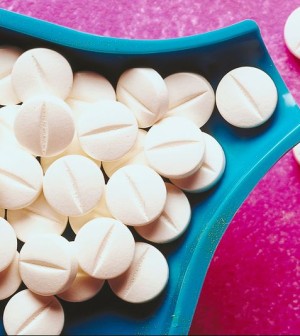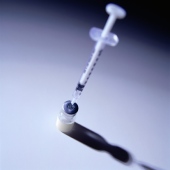- Double Mastectomy May Offer No Survival Benefit to Women With Breast Cancer
- Toxic Lead Found in Cinnamon Product, FDA Says
- Certain Abbott Blood Sugar Monitors May Give Incorrect Readings
- Athletes Can Expect High Ozone, Pollen Counts for Paris Olympics
- Fake Oxycontin Pills Widespread and Potentially Deadly: Report
- Shingles Vaccine Could Lower Dementia Risk
- Your Odds for Accidental Gun Death Rise Greatly in Certain States
- Kids From Poorer Families Less Likely to Survive Cancer
- Tough Workouts Won’t Trigger Cardiac Arrest in Folks With Long QT Syndrome
- At-Home Colon Cancer Test Can Save Lives
HPV Vaccination Rates Among Teens Still Lagging: CDC


THURSDAY, Aug. 29Not enough teens are getting the vaccine that protects against the human papillomavirus (HPV), and doctors’ reluctance to recommend it may be part of the reason why, U.S. health officials reported Thursday.
Although the tetanus, diphtheria and acellular pertussis (Tdap) vaccination rate has risen to 84.6 percent of teens, only 20.8 percent of boys and 53.8 percent of girls have had a least one dose of the HPV vaccine, according to the report from the U.S. Centers for Disease Control and Prevention.
“We have continued to have increases in coverage for 14- to 17-year-olds for the Tdap vaccine and there is still progress on the meningococcal conjugate (MenACWY) vaccine, but our coverage is not moving forward with the HPV vaccine for girls, and coverage is low for the HPV vaccine for boys,” said Dr. Melinda Wharton, deputy director of the CDC’s National Center for Immunizations and Respiratory Diseases.
The reason HPV vaccination among girls is lagging is because doctors aren’t routinely recommending it when they give Tdap and MenACWY vaccinations, Wharton said.
“Although providers are very good about conveying the need for Tdap and MenACWY, they are less strong in making a recommendation for the HPV vaccine,” Wharton said. “This could be because they are anticipating parental concerns.”
The CDC now recommends that every boy and girl aged 11 to 12 get the HPV vaccine, which is given in three shots. The vaccine is both safe and effective, and prevents up to 70 percent of cervical cancers and 90 percent of vaginal warts.
In addition, the vaccine protects against some cancers of the head and neck, according to the CDC.
Some people worry that getting the HPV vaccine will make girls more sexually active. “But we need to protect them, because if we don’t we are leaving them unnecessarily vulnerable to serious and deadly diseases that could be prevented, and we just can’t do that, ” Wharton said.
Wharton said HPV vaccination is a regular part of the vaccine schedule and should not be treated as anything special or different.
The fact that HPV is sexually transmitted shouldn’t be a concern, she said. “The fact of the matter is this vaccine prevents cancers,” she said.
“We don’t have to get into a conversation about how pertussis is transmitted,” she said. “We say what the vaccine is for and we make a recommendation, and if people have questions they can ask those questions. It is not necessary to get into long discussions about questions that people haven’t even asked.”
The report was published in the Aug. 30 edition of the CDC publication Morbidity and Mortality Weekly Report.
Dr. Jennifer Wu, an ob/gyn at Lenox Hill Hospital in New York City, said that “some parents see HPV as a sexually transmitted disease and they are worried that it will encourage sexual activity, but I don’t think most children are looking at HPV that way.”
Another barrier to getting the HPV vaccine is the cost. “It’s very expensive,” Wu said. “But the cost of treating cervical cancer and genital warts can also be very expensive.”
According to the American Cancer Society, the vaccine can cost about $130 per dose. When doctor’s fees are added, the three shots could cost $500 or more. The vaccine, however, is covered by most health insurance plans and government programs.
The MenACWY vaccine also is important, the researchers added. It protects against meningococcal disease. Although not common, 16- to 21-year-olds have the highest rates of the bacterial infection, according to the CDC.
Meningococcal bacteria can lead to severe diseases, including meningitis and sepsis, resulting in permanent disabilities such as amputations, brain damage, hearing loss and blindness. The disease can even be fatal.
According to the report, the Tdap vaccination rate for teens increased from 78.2 percent in 2011 to 84.6 percent in 2012, while the MenACWY vaccination rate increased from 70.5 percent in 2011 to 74 percent in 2012.
For boys, the HPV vaccination rate went from 8.3 percent in 2011 to 20.8 percent in 2012; the recommendation for vaccinating boys is new, so coverage is expected to be low at first.
At 53.8 percent, the HPV vaccination rate among girls in 2012 was the same as it was in 2011. Moreover, only one-third of those girls received all three doses of the vaccine, according to the report.
Vaccination rates also varied by state. The National Healthy People 2020 targets for teens were met or exceeded in 36 states for Tdap and in 12 states for meningococcal vaccination, but no state met the HPV vaccination target set for girls, the researchers said.
More information
For more on the HPV vaccine, visit the U.S. Centers for Disease Control and Prevention.
Source: HealthDay
Copyright © 2024 HealthDay. All rights reserved.










